Performance Measures Report 2020
Burlington Electric Department (BED) is pleased to present the 2020 Performance Measures Report (PMR) to provide information about our work for the benefit of our customers and the community. The PMR looks different this year compared to prior years, with an emphasis on providing data tracking against our various metrics across areas such as customer care, safety, reliability and generation, renewable energy, rates and bills, energy efficiency, and Net Zero Energy. For a more detailed narrative on BED’s work in 2020 please read our section (pp. 33-37) of the City’s Annual Report for 2020.
Responding as a Community to the Pandemic and the Climate Emergency
2020 brought unexpected challenges for Burlington, our customers and local community, and communities around the world. BED prioritized supporting our customers, employees, and community in response to the COVID-19 pandemic, while also focusing on continued efforts to make progress on our Net Zero Energy city goal.
Supporting our Customers and Community
As the Stay Home/Stay Safe orders went into effect, BED worked to support our customers by suspending disconnections for non-payment, late fees, and interest. We provided new payment plan options to help customers who are behind on their bills and partnered with the Department of Public Service to deliver utility bill assistance from CARES Act funds to hundreds of our customers. We encourage Burlingtonians impacted by the pandemic to contact our Customer Care team at 802.865.7300 or online for help. The BED team also supported the Burlington Resource and Recovery Center, providing communications, customer care, technology, and policy support for this broader City-wide effort.
Keeping Team Healthy and Safe, While Continuing to Provide Exceptional Customer Care
We also took immediate steps following the Stay Home/Stay Safe orders to keep our BED employees healthy and safe, including implementation of a remote work program that utilizes video technologies to ensure that our team stays connected. Our information technology staff provided invaluable support as BED transitioned approximately two-thirds of our organization to remote work. Even working from home, BED’s Center for Customer Care continues to deliver exceptional customer care by focusing on first-call resolution. Our efforts, once again in FY20 for our third consecutive year, have served our customers without a single escalation to the Department of Public Service (DPS).
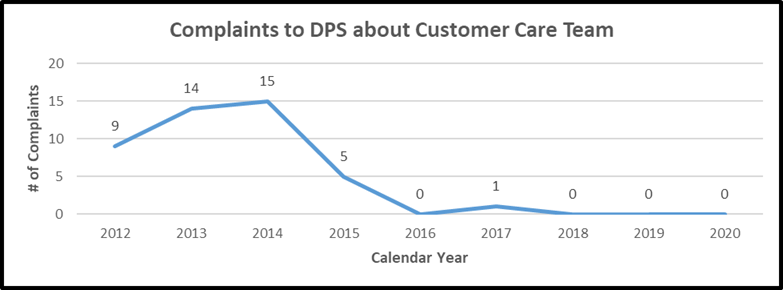 At the same time, we have maintained on-site teams at our offices and generation facilities to keep the lights on and continue providing reliable service. Our Center for Safety has worked to ensure compliance with City and State face-masking and physical distancing guidelines.
At the same time, we have maintained on-site teams at our offices and generation facilities to keep the lights on and continue providing reliable service. Our Center for Safety has worked to ensure compliance with City and State face-masking and physical distancing guidelines.
Continuing our Progress on Net Zero Energy and New Green Stimulus Program
While we worked hard to support customers during the pandemic, we also focused on prioritizing continued progress toward our community’s Net Zero Energy goal, following on the launch of our Net Zero Energy Roadmap in September 2019. 2020 was a year of significant accomplishment with respect to Net Zero Energy, as BED tripled our state target for electrification and fossil fuel reduction under Tier 3 of Vermont’s Renewable Energy Standard. New data available in April 2021 indicated that Burlington is ahead of the pace of emission reduction in 2020 relative to the Net Zero Energy Roadmap goal; however, a portion of that progress is due to reduced vehicle miles traveled during the pandemic. Continued utilization of remote work/telework technologies now that the Burlington and Vermont economies have reopened fully, combined with additional efforts to continue fare free transit and expand walking and biking opportunities will be critical in mitigating an emissions rebound effect.
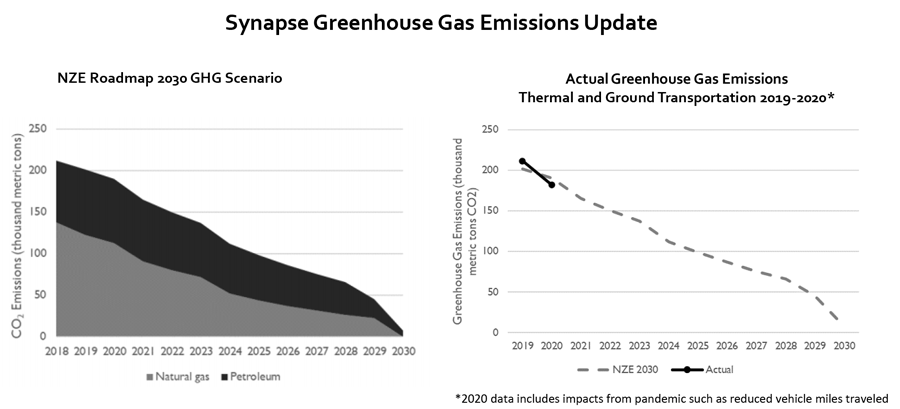
During 2020, we welcomed the first two electric buses to the Green Mountain Transit fleet, and advanced the district energy system (DES) project to Phase II in February of 2020 (DES now is in Phase III of feasibility work as of May 2021). In April 2020, during his State of the City address, Mayor Miro Weinberger announced that BED would launch a Green Stimulus program to support economic recovery and climate progress.
The Green Stimulus redirected unspent energy efficiency funds to support Net Zero Energy initiatives with increased incentives for cold climate heat pumps, electric vehicles, efficient appliances, and more. The increased incentives have boosted the City’s residential heat pump installations under BED’s strategic electrification program by more than six times since June of 2020, reducing greenhouse gas emissions and helping our installers and contractors return to work. Additional programs include providing 100 percent of the cost of electric efficiency upgrades for affordable housing developments, providing zero-percent loans for low- and moderate-income customers (in partnership with local credit unions) to replace old appliances with more efficient models, and low-cost electric bike purchase options (in partnership with Burlington nonprofit Old Spokes Home). Thanks to a grant from the U.S. Economic Development Administration through the CARES Act, the Green Stimulus also includes zero-percent loans for nonprofit and small business customers to replace failing heating systems, or upgrade ventilation in response to health guidelines. The Mayor and BED announced in January 2021 that Green Stimulus will continue through 2021.
Also in 2020, BED launched new modern electric induction cooking incentives and electric leaf blower rebates. BED worked to expand the benefits of driving electric, continuing to partner with CarShare Vermont to support its efforts to add all electric and plug-in hybrid vehicles to its fleet, and added level 2 chargers at multi-family buildings across Burlington through a partnership with EVmatch. We have increased low- and moderate-income customer participation in our electric vehicle rebate programs, with approximately 20 percent of all rebates going to income-qualified customers or for pre-owned vehicle purchases.
In adopting an updated Strategic Direction for 2020-21, BED worked with our Electric Commission on the adoption of a new goal that commits BED to work to: “Ensure all programs are equitable and accessible, with a priority given to low-to-moderate income, rental, Black, Indigenous, and People of Color (BIPOC), immigrant, and refugee populations.” Initiatives to support this goal have included an Energy Coaching pilot in the Old North End through which our Energy Services team visited the Family Room parent-child center for in-person energy consultations with community members in their neighborhoods. Additionally, we initiated new equity trainings for BED staff utilizing curriculum from the Urban Sustainability Directors Network, and BED staff served on the City’s Racial Equity Inclusion and Belonging (REIB) team.
BED proposed a Fiscal Year 2021 (FY21) budget that again included no rate increase, marking our 12th year without raising rates, a period during which the average retail price of electricity increased by over 20 percent statewide. However, the pandemic has impacted BED’s finances in several ways, including through lower sales to customers, disrupted capital projects and supply chain, and higher customer arrearages.
BED is proud as always to serve our community and provide safe, reliable, and affordable service during such a challenging time. We are pleased to present the metrics below detailing our progress on key initiatives, including Net Zero Energy fossil fuel and greenhouse gas emissions reduction data that has been updated for 2019 and 2020 by our Net Zero Energy Roadmap consultant, Synapse Energy Economics.
Safety
At BED, safety is our number one value. BED created the Center for Safety in 2019 to elevate the visibility and commitment of safety’s role throughout the organization. The Center for Safety includes the areas of Safety, Environmental, Risk Management, General Services, Purchasing, and Inventory. The roles and tasks of each area closely align with our core safety goals of protecting people, assets, and property.
| 2020 | 2019 | 2018 | 2017 | 2016 | 2015 | |
|---|---|---|---|---|---|---|
| Lost time incident rate (# incidents) target: ≤ 3.5 |
0.93 | 0.89 | 1.89 | 0.96 | 0.97 | 1.85 |
| Lost time severity rate (# days) target: ≤ 71.0 |
41.71 | 78.21 | 109.75 | 1.92 | 4.86 | 41.69 |
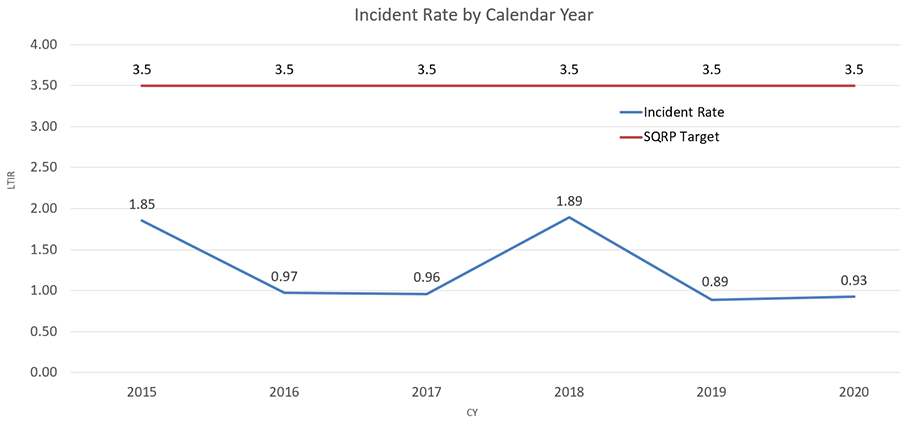
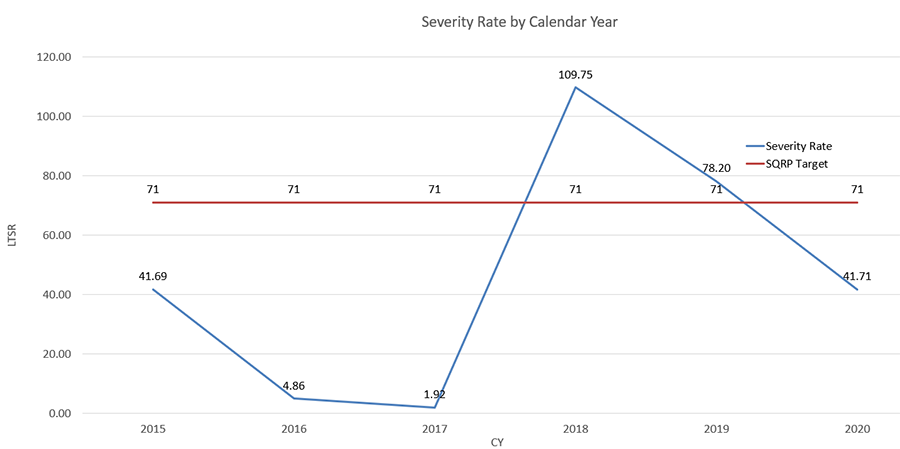

Reliability and Generation
In 2020, BED continued efforts to improve our distribution system’s reliability and efficiency, as well as replaced and upgraded our infrastructure in several areas. The average number of customer interruptions was 1.5, better than our target of 2.1. The average time of our interruptions was 0.55 hours, better than our target of 1.2 hours.
| 2020 | 2019 | 2018 | 2017 | 2016 | |
|---|---|---|---|---|---|
| Average # customer interruptions target: 2.10 |
1.5 | 1.02 | 0.4 | 0.7 | 0.6 |
| Average hours of interruptions target: 1.20 |
0.55 | 0.75 | 0.9 | 0.9 | 1.0 |
After 36 years of producing renewable energy, the McNeil Generating Station continues to contribute to the local economy with approximately 65 wood suppliers bringing sustainably harvested wood chips to the plant as often as six days a week. During 2020, the plant produced 229,725 net MWh of power while using 366,465 tons of wood with a capacity factor of 52.3 percent. The annual capacity factor for McNeil is defined as the ratio of its actual output to its potential output if it were possible for it to operate at full capacity continuously for one year.
| McNeil Generating Station | 2020 | 2019 |
|---|---|---|
| MWH generated | 229,725 | 227,247 |
| Availability factor | 74.8% | 72% |
| Capacity factor | 52.3% | 51.8% |
| Winooski One Hydro | 2020 | 2019 |
|---|---|---|
| MWH generated | 24,934 | 33,247 |
| Availability factor | 91.5% | 96% |
| Capacity factor | 37.3% | 51% |

Learn more about BED’s sustainable forestry work.
Renewable Energy
In 2014, Burlington become the first city in the nation to source 100 percent of its power from renewable generation. Below is BED’s 2020 energy supply pre-renewable energy credit (REC) sales and post-REC sales and purchases.
BED’s power supply reflects a number of considerations including cost, renewability, predictability, reliability, diversity, and other economic and environmental impacts. While cost is always critical, other factors influence purchase decisions. BED has succeeded in maintaining comparatively low and stable rates, while continuing our commitment to renewables and, to the extent possible, keeping money in Vermont by supporting Vermont-based renewable generation.
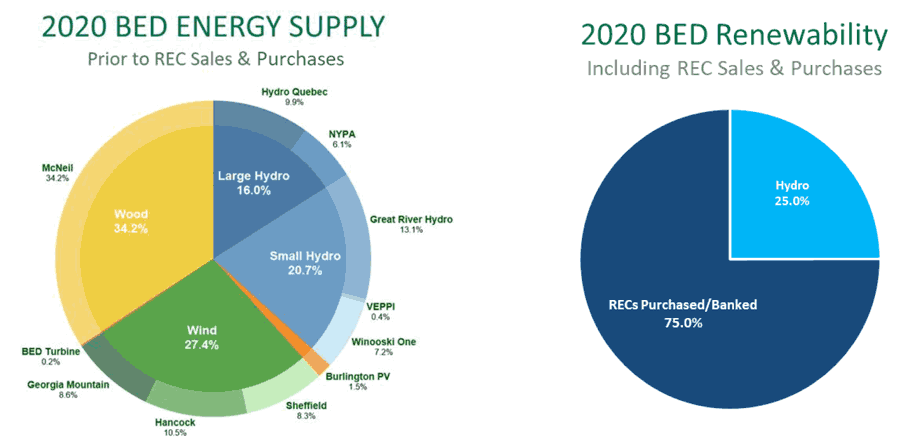 Note: BED’s energy purchases exceeded customer needs in 2020 by 8%. As a result, the chart on the left reflects percentage of total purchases, not sales to customers.
Note: BED’s energy purchases exceeded customer needs in 2020 by 8%. As a result, the chart on the left reflects percentage of total purchases, not sales to customers.
Solar Development
Solar, particularly rooftop solar, represents one of the relatively few options for additional renewable generation in Burlington. Solar in Burlington is made up of net metering arrays owned by customers (or on customer’s property), solar owned by BED itself (at the Burlington International Airport and atop BED’s Pine Street offices), and solar under contract to BED (Purchase Power Agreements or “PPAs”). Net metering in Burlington has grown every year since the program began and, most recently, the South Forty Solar array in the New North End began delivering energy under a PPA (there are six other solar PPAs, but they are much smaller). By harnessing the power of the sun, BED produced energy when we needed it the most: in the summer. BED is a summer-peaking utility, meaning that our largest loads are during summer months. Solar helps ease the load. Total energy deliveries from solar resources in Burlington include those from the two BED-owned arrays mentioned above, from a number of solar arrays under contract to BED, and from arrays under the Vermont net metering programs. Total solar output from these sources continues to climb, and saw a large increase in 2018 due to the South Forty Solar array coming online.
Burlington was the leading solar city in the northeast region for per capita solar capacity according to the Shining Cities 2020 Environment America report.
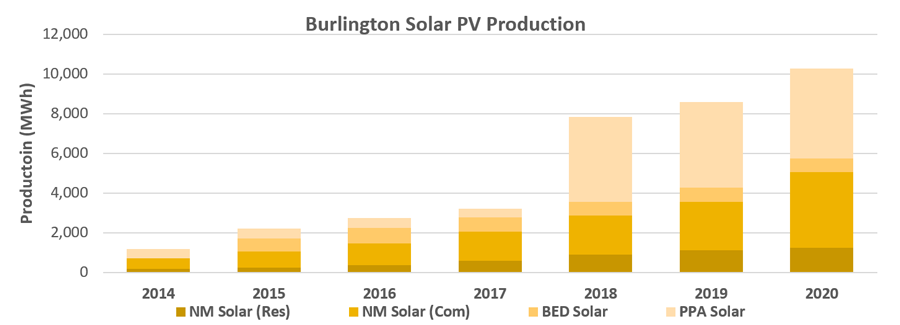 Source: Burlington Electric Department
Source: Burlington Electric Department
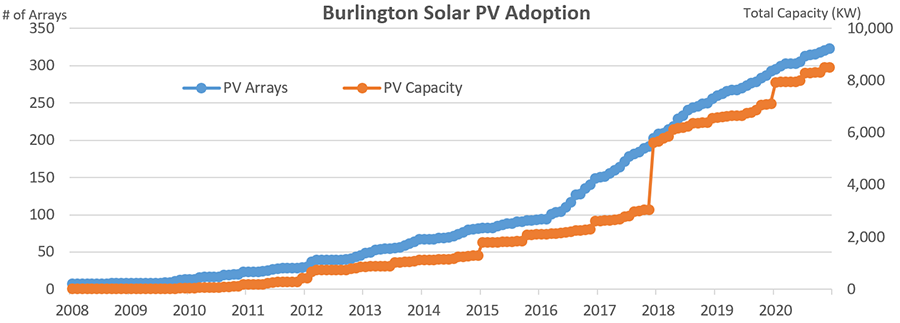 Source: Burlington Electric Department
Source: Burlington Electric Department
Rates and Bills
BED provides electric service to 17,457 residential customers and 3,995 commercial and industrial customers. Commercial and industrial customers use much more electricity than residential customers, accounting for 70 percent of electricity sales.
In fiscal year 2022 (beginning July 1, 2021), BED proposed a 7.5 percent rate increase, scheduled to take effect as a bill surcharge in August 2021. The figures below reflect BED rates and bill data prior to the rate case. Customers interested in learning more about the rate case and/or in applying for our temporary energy assistance program are invited to visit our rates page.
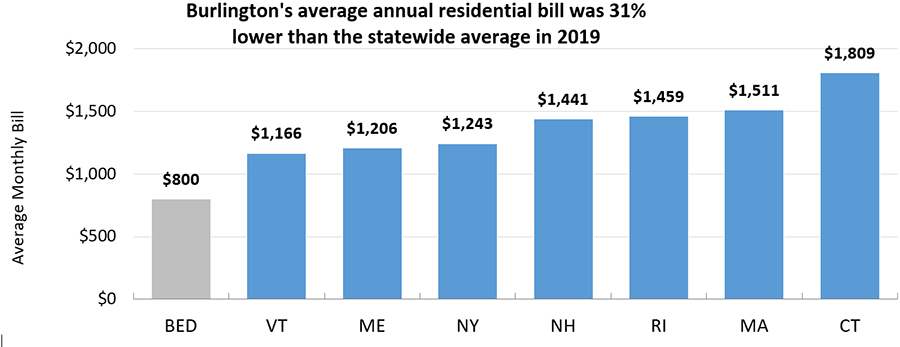
Source: Energy Information Administration
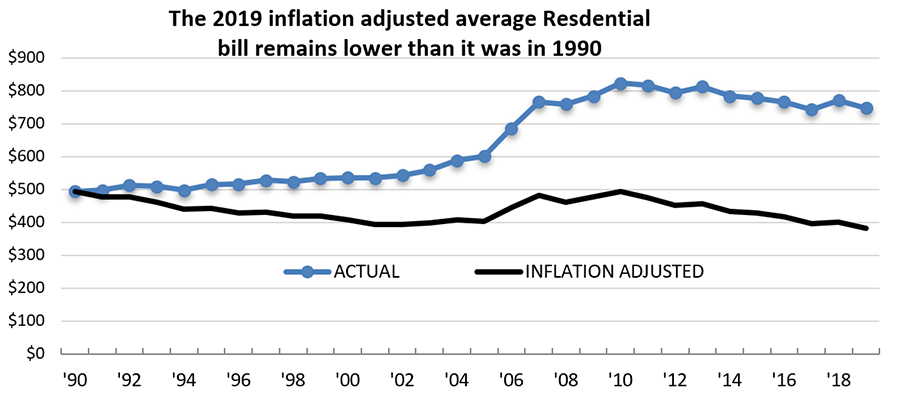
Source: Burlington Electric Department
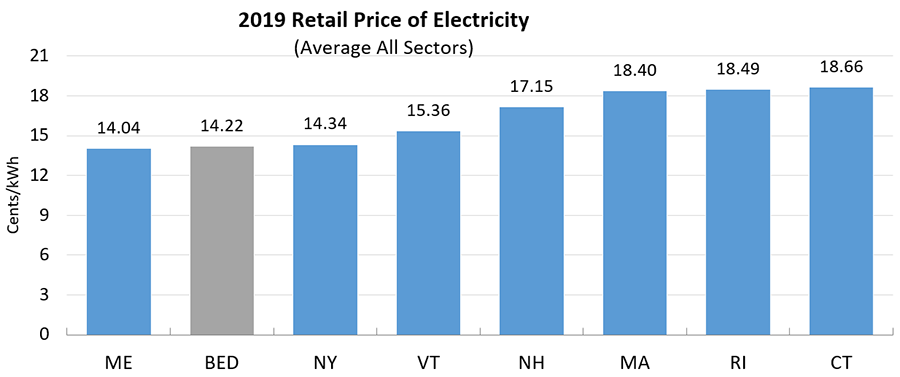
Source: Energy Information Administration
Energy Efficiency
BED is an Energy Efficiency Utility (EEU) appointed by the Public Utility Commission (PUC). As of year-end 2020, electricity consumption in Burlington is approximately 8.6 percent lower today than in 1989 (adjusted to remove COVID-19 impacts – actual electric consumption in 2020 was 12.3 percent lower than in 1989, when including COVID-19 impacts). From 1989-2018, statewide electric consumption increased more than 10 percent. Over same period, U.S. consumption increased more than 30 percent. BED and our customers have invested over $72 million, including an $11.3 million bond for efficiency in 1990. Energy efficiency investments in Burlington are saving our customers approximately $10.4 million annually on electric bills, including avoided energy and transmission and capacity costs. Through Green Stimulus, our BED efficiency program now covers 100 percent of eligible energy efficiency upgrades for affordable housing providers, and pre-approved weatherization projects now receive up to 75 percent incentive.
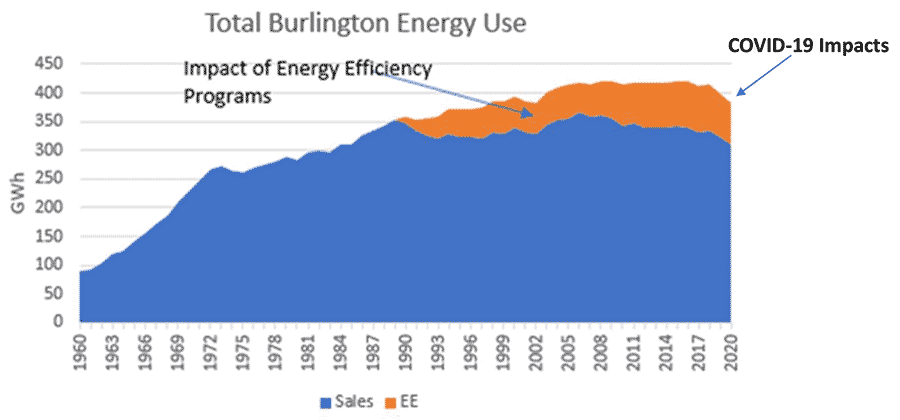 BED’s efficiency programs have helped to keep Burlington’s electricity usage below 1989 levels.
BED’s efficiency programs have helped to keep Burlington’s electricity usage below 1989 levels.
Net Zero Energy
BED’s vision is to make Burlington a Net Zero Energy city across electric, thermal, and ground transportation sectors by managing demand, realizing efficiency gains, and expanding local renewable generation while increasing system resilience. The Net Zero Energy Roadmap was adopted by the City Council in September 2019. The Roadmap project involves all City Departments, and contemplates work with key external partners such as Champlain Valley Weatherization Services and VGS for weatherization efforts and district energy. Burlington’s Net Zero Energy Roadmap is the most ambitious local climate change plan in the nation that BED is aware of, recognized by the Smart Electric Power Alliance as the “first US Net-Zero 2030 plan.” The Roadmap recognizes that technology developments and pricing, technology adoption curves, and the level of widespread community engagement and participation in using new technologies will affect progress toward the Net Zero Energy goal.
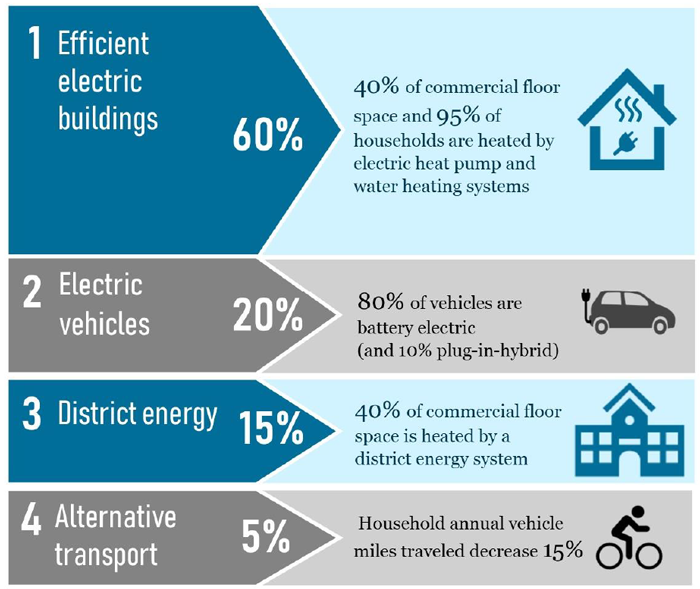 The Synapse update shows greenhouse gas emissions were lower in 2019 and 2020 in Burlington, compared with 2018 baseline. Emissions in 2020 were impacted in part by the pandemic, but were at 182 thousand metric tons of CO2 compared to a Roadmap goal in 2020 of 190 thousand metric tons, meaning we are actually a little ahead of pace. However, there is a risk of emissions rebounding when the economy more fully reopens, and mitigation steps to limit the increase in vehicle miles traveled may include updated telework and remote work policies by Burlington area businesses and organizations. Also, while we are not yet meeting the ambitious Roadmap pace for electrification measures such as EVs and heat pumps, in 2020 BED tripled its state requirement for electrification/fossil fuel use reduction under Tier 3 of Vermont’s Renewable Energy Standard, and the lifetime emissions reduction from the BED Tier 3/Net Zero incentives alone in 2020 are approximately 25,000 tons of CO2, equivalent to removing 8,500 cars from the road for one year.
The Synapse update shows greenhouse gas emissions were lower in 2019 and 2020 in Burlington, compared with 2018 baseline. Emissions in 2020 were impacted in part by the pandemic, but were at 182 thousand metric tons of CO2 compared to a Roadmap goal in 2020 of 190 thousand metric tons, meaning we are actually a little ahead of pace. However, there is a risk of emissions rebounding when the economy more fully reopens, and mitigation steps to limit the increase in vehicle miles traveled may include updated telework and remote work policies by Burlington area businesses and organizations. Also, while we are not yet meeting the ambitious Roadmap pace for electrification measures such as EVs and heat pumps, in 2020 BED tripled its state requirement for electrification/fossil fuel use reduction under Tier 3 of Vermont’s Renewable Energy Standard, and the lifetime emissions reduction from the BED Tier 3/Net Zero incentives alone in 2020 are approximately 25,000 tons of CO2, equivalent to removing 8,500 cars from the road for one year.
Currently, Burlington is on the Net Zero Energy 2030 path.
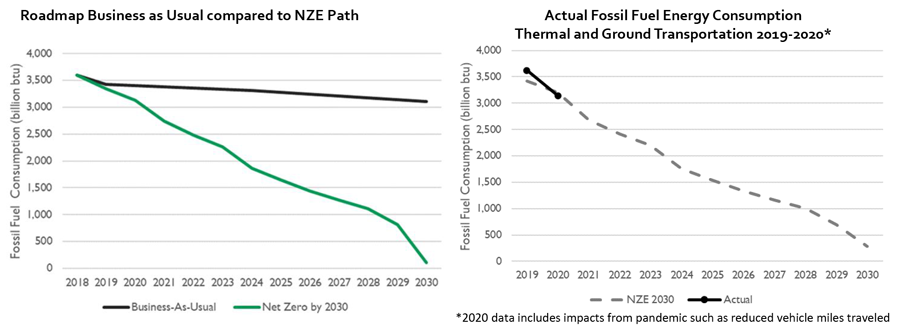 Synapse Energy Economics Net Zero Energy Roadmap Update for 2019 and 2020 Data – Commissioned by BED
Synapse Energy Economics Net Zero Energy Roadmap Update for 2019 and 2020 Data – Commissioned by BED
In 2020, BED tripled its state requirement for electrification/fossil fuel reduction under Tier 3. Approximately 25,000 tons of CO2 lifetime reduction for Tier 3 measures implemented in 2020 alone. This is emissions equivalent to removing over 8,500 cars from the road for a year. A typical Vermont passenger vehicle emits approximately 3 metric tons of carbon dioxide per year.
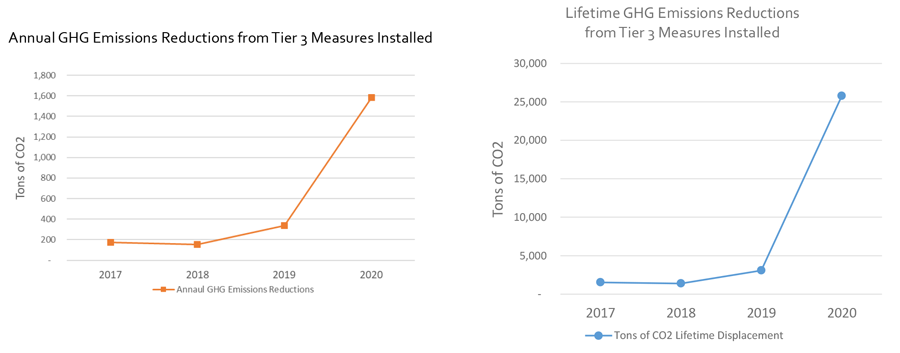
Key Takeaways from the 2021 Roadmap Update
- Fossil fuel use and greenhouse gas emissions in Burlington were lower in both 2019 and 2020, compared to 2018 baseline.
- Greenhouse gas emissions are down more than 15 percent in 2020 compared to 2018 levels.
- Natural gas use in 2020 in Burlington was down approximately 10.5 percent from 2018 levels (not weather normalized).
- Gasoline and diesel consumption for transportation was down approximately 23.6 percent.
- In 2020, Burlington is ahead of pace for emissions reduction compared to NZE 2030 goal for the year – 182,000 metric tons of CO2 compared with NZE 2030 goal of 190,000 metric tons.
- In 2020, the pandemic impacted vehicle miles traveled and gasoline use significantly – Synapse estimated 6,415 miles per vehicle compared to baseline of 8,000.
- While we have made significant progress on strategic electrification, particularly in 2020, we are not yet on pace for the Roadmap goals for heat pumps and EVs.
- There is an emissions rebound risk as the economy more fully reopens following the pandemic. Remote work and telecommuting options may help mitigate this rebound.
- We must redouble our efforts to switch to technologies such as heat pumps and EVs which can lock in emission reductions in a more durable way.
Board of Electric Commissioners
Gabrielle Stebbins, Chair | Scott Moody, Vice Chair | Jim Chagnon | Robert Herendeen | Bethany Whitaker
Visit the Board of Electric Commissioners page.
Past Performance Measures Reports
- 2019 Performance Measures Report
- 2018 Performance Measures Report
- 2017 Performance Measures Report
- 2016 Performance Measures Report
- 2015 Performance Measures Report
- 2014 Performance Measures Report
- 2013 Performance Measures Report
- 2012 Performance Measures Report
- 2011 Performance Measures Report
- 2010 Performance Measures Report
- 2009 Performance Measures Report
